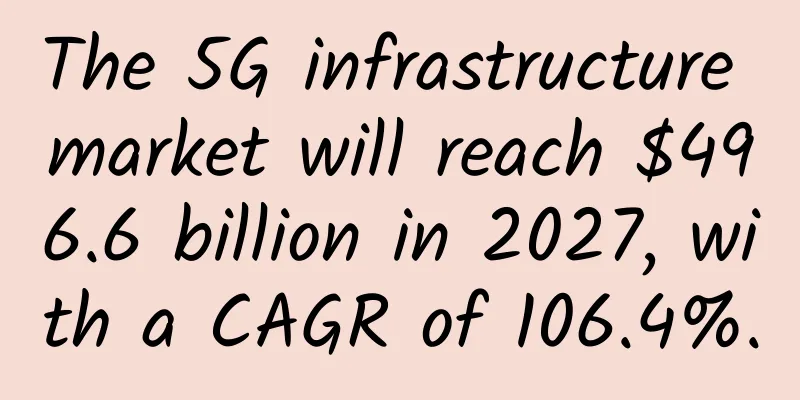The 5G infrastructure market will reach $496.6 billion in 2027, with a CAGR of 106.4%.

|
According to a new study released by market research firm Grand View Research, the global 5G infrastructure market size is estimated to reach US$496.6 billion by 2027, with a compound annual growth rate of 106.4% from 2020 to 2027. Communications service providers are investing in the deployment of 5G infrastructure to provide improved data services across multiple vertical industries, and this investment is driving the rapid growth of the market. At the same time, it is expected that extensive research and technological advancements in the field of network technology will reduce the overall installation cost of next-generation 5G network equipment and deployment modules. This, in turn, is expected to promote and accelerate the deployment of 5G technology and related infrastructure. According to the report, by 2027, the size of the RAN segment is expected to reach US$214.7 billion, with a compound annual growth rate of 112.3% from 2020 to 2027, due to a significant increase in investment in deploying 5G cloud or centralized RAN in major countries and regions such as the United States, the United Kingdom, Japan and China. The demand for 5G technology and related infrastructure in the industrial sector is expected to witness considerable growth during the forecast period as the need to provide unified connectivity between IIoT (Industrial Internet of Things) devices and collaborative robots continues to grow. Meanwhile, huge investments made by infrastructure providers in installing 5G standalone networks to provide ultra-reliable and low-latency connectivity for connected car applications are expected to drive the market growth during the forecast period. The Sub-6 GHz segment is expected to reach the largest market size of USD 302.4 billion by 2027, primarily due to the government’s focus on releasing Sub-6 GHz spectrum bands for high-speed data services in major developed economies. On the supplier side, leading players such as Ericsson and Nokia will be highly focused on building partnerships with leading service providers to increase their geographic and overall market share. The demand for high-bandwidth connections for a variety of applications, including ultra-high-definition (UHD) video viewing, cloud-based AR/VR gaming, and HD video conferencing, will grow significantly throughout the forecast period. Furthermore, vertical industries including manufacturing, oil and gas, mining, energy, and utilities are investing heavily in the deployment of robust 5G networks in order to improve overall productivity and operational efficiency. Hence, the growing demand for high-bandwidth capacity to help facilities establish unified connectivity across millions of Industrial Internet of Things (IIoT) devices is expected to boost the global market growth from 2020 to 2027. With the advent of 5G technology, the transportation and logistics industry is expected to gradually shift towards an autonomous ecosystem. The deployment of 5G networks is expected to help provide seamless data speeds with low latency for various transportation applications including transport cars, autonomous vehicles, and transport ships. Furthermore, the demand for high-speed bandwidth capacity, especially in healthcare applications including telemedicine and remote patient surgery, is expected to further strengthen the market growth in the near future. Likewise, the proliferation of smart cities across the globe will support this growth. The ongoing COVID-19 pandemic has had an adverse impact on the market. Several global telecom equipment manufacturers have temporarily closed their production facilities and stopped the export of 5G equipment. Federal governments in major countries and regions such as the United States, France, the United Kingdom, and Australia have temporarily postponed 5G spectrum auctions. Furthermore, the escalating trade war between the two largest economies, China and the U.S., and concerns over security issues are estimated to pose challenges to market growth to some extent for at least the next year and a half. |
<<: NDRC: Accelerate the layout of new infrastructure such as 5G and the Internet of Things
>>: Analysis of global 5G infrastructure market development trends from 2020 to 2027
Recommend
[Black Friday] Sharktech: 50% off on all cloud products, 10Gbps unlimited traffic server $349/month-2*Gold 6148/128G/2TB NVMe/Los Angeles and other data centers
Sharktech also released a promotion during this y...
A brief discussion on operation and maintenance under SDN architecture
At present, the domestic network operation and ma...
Is WeChat and QQ file transfer too inhumane? Here's how to fix it
For example, if the other party sends a file to y...
Spain's 5G state subsidies may exclude Huawei, Huawei appeals
On October 10th, local time on Monday, Huawei app...
The birth of the "Huawei Industry Fertile Soil Platform" - the empowerment and counter-empowerment of Huawei Cloud and its ecosystem partners
[Original article from 51CTO.com] At the Huawei C...
5G is still a long way off, but some people are already discussing 6G
It often takes many years for network technology ...
Hyperscale Data Centers vs Micro Data Centers
Some say the data center of the future is very di...
[Black Friday] SoftShellWeb: $8.99/month-1GB/20GB/100GB@1Gbps/Taiwan VPS
SoftShellWeb has released several special promoti...
How to redirect HTTP to HTTPS in Nginx
Nginx, pronounced "Engine x", is a free...
Operators set different network speeds for 5G packages: some are even worse than 4G
Not long ago, the Ministry of Industry and Inform...
The three major cloud service giants join forces with telecom operators to participate in the battle for the 5G market
Connectivity services have become even more impor...
SpeedyPage 10% off, starting from $4.83/month-AMD Ryzen, DDR5 memory, Gen4 NVMe, Ashburn computer room
SpeedyPage recently launched a high-performance V...
The price of 4G mobile chips will rise instead of fall in the second half of 2021
As mobile chip suppliers focus more on 5G solutio...
How to ensure wireless network infrastructure supports Wi-Fi 6/6E?
As the use of wireless devices continues to soar ...
RackNerd: $16.5/year KVM-1.5GB/20GB/3TB/Los Angeles MC Data Center
A few days ago, I shared a list of LETs, and Rack...









